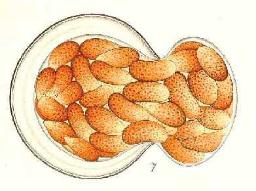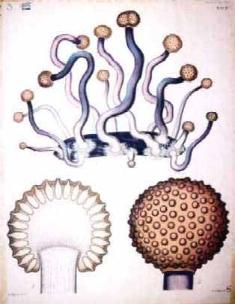Botanical Wallcharts
by Leopold Kny, Germany
120 charts 1874-1911
This series of Botanical Wall Charts was the result of original research by Leopold Kny, Professor of Plant Physiology at the University of Berlin. It was originally accompanied by a 554-page explanatory text-book. Such was the precision and accuracy of Kny's drawings that they were still being used in botanical teaching more than a century after the series was begun. Of the initial series of 100 charts, the University Museum Collections currently hold 80.
 Detail from Table XLVIII, showing stages in the development and growth of the Golden Alga, Botrydium granulatum. These minute organisms are found in sea or fresh water and characteristically swim around by means of two tiny hair-like structures, called the flagella.
Detail from Table XLVIII, showing stages in the development and growth of the Golden Alga, Botrydium granulatum. These minute organisms are found in sea or fresh water and characteristically swim around by means of two tiny hair-like structures, called the flagella.
 Table XLIII - Claviceps purpurea
Table XLIII - Claviceps purpurea
This is one of the Ergot fungi which attack cereals (mainly rye, wheat and barley). When made into flour the fungus releases toxins that cause the disease ergotism in humans. Since the symptoms include hallucinations, it has been suggested that many of those who were accused of witchcraft in medieval times may simply have been eaten mouldy grain! The toxic alkaloids now have a medicinal use in stimulating muscle contractions.
A complete set of digitised images of the Kny charts can be seen on the Memory of the Netherlands website.